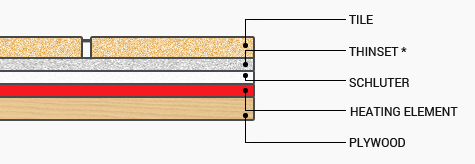An uncoupling membrane provides a break between two rigid surfaces. In other words, it allows both surfaces to move independently. When you bond tile directly to a rigid surface, say concrete or cbu, or even plywood, the thing between them must have enough flexibility to keep the stresses low enough so that the bond can keep them attached. When that bond between two rigid surfaces is thinset, that thinset must have some flexibility, and that is why you may need a modified thinset to reliably hold things together when bonding directly. Ditra can also be used and acts as a thinset modifier.

But, if you’ve ever touched something like Ditra, you’d know that it is a flexible polyethylene matrix. While the membrane’s fleece IS bonded to the substrate, thinset does NOT stick to Ditra, and there are voids between the pillars that hold the tile up which means that if a lateral stress is applied, the whole tile and thinset layer can move totally independently of the subfloor or slab only restricted by the flexibility of the Ditra membrane. The membrane can move MUCH further than any difference in the expansion coefficient of the tile and any rigid substrate. Therefore, while the bond to a tile is less strong than that when you might use a modified, that bond is made under ideal conditions (the water is trapped, and can allow the cement curing to complete growing the crystals that actually create the bond to their maximum capability) and the thinset and tile can move without putting any stress on the tile-thinset bond. Plus, when you use an unmodified thinset to bond things, the cure occurs in a reliable timeframe. I was in a class this week, and the instructor talked about one test they did using a glass tile over a waterproof membrane (Ditra). You could see the thinset through the tile, and could tell the difference between ‘wet’ uncured thinset and cured. They watched that tile for 90-days seeing that grey spot shrink, until it finally was entirely dry. This is the reason Schluter doesn’t want you to use a modified thinset over Ditra…until that modified thinset has fully cured, it is still soft and being conservative, they do not want your installation to fail…a dryset (unmodified) thinset has many times more strength than the stresses that can be applied through the flexible Ditra uncoupling membrane. Think of the Ditra as the modifier in your thinset, and it can stretch MUCH more than a modified between two rigid surfaces AND, it reaches that strength in a know, short timeframe. IOW, if you understand how this works, your trepidation about modified goes away when told to use an unmodified when using Ditra.
Note that porcelain tile and glass has been used in tiling for many centuries – many churches and public buildings are still up and in use after hundreds of years with their tile intact. Porcelain tile was first used in China somewhere around the 1300’s. Modified thinsets weren’t invented and only came into use in the middle of the 20th century. And, the cement they used to hold the tile in place was much less pure than what is in today’s thinsets. A dryset mortar is mostly cement and sand or other inert fillers. Those old installations used an uncoupling layer to isolate the tile from any movement. Ditra does the same thing, and is most reliable using today’s modern equivalent cement product – a dryset mortar.
Whenever not using an uncoupling layer, a modified thinset IS a good insurance, but is a detriment when used over a waterproof uncoupling membrane like Ditra.
Because of the fleece on both sides of Kerdi, you get a similar, but by no means as extensive, uncoupling. But, also consider that a typical shower is composed of much smaller sections than a large floor system, and that is enough. That’s also one reason why the TCNA calls for the changes of plane in a shower to not be grouted…this means that each wall and the floor are independent and not impacted by the other sides, and those sides are relatively small, keeping the shear stresses down. If the shear stresses are kept in check, the bond strength of the mortar is at least 150psi with any mortar, and a good dryset can achieve upwards of 300psi under ideal conditions. A modified can achieve more (not all do), but if the shear stresses are relieved, there’s no way you could ever pull a tile off that surface unless you use excessive force – way beyond any normal day-to-day use factors.
You can find more installation information about our product on our FAQ and Cut Sheet Installation Guidelines page. Feel free to Contact Us for questions and help.
Interested in adding a heated floor to your home?
Come see our line of products!

